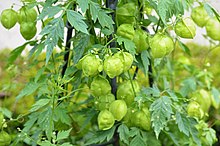Cardiospermum halicacabum
| Cardiospermum halicacabum | |
|---|---|

| |
| Scientific classification | |
| Kingdom: | |
| (unranked): | |
| (unranked): | |
| (unranked): | |
| Order: | |
| Family: | |
| Subfamily: | |
| Genus: | |
| Species: | C. halicacabum
|
| Binomial name | |
| Cardiospermum halicacabum | |
Cardiospermum halicacabum, known as the balloon plant or love in a puff, is a climbing plant widely distributed in tropical and subtropical Africa and Asia.[1] Often found as a weed along roads and rivers, it has been examined for antidiarrhoeal[2] as well as homoeopathic medicinal[1] properties.
The 1889 book 'The Useful Native Plants of Australia records that other common names were "Broad-leaved Apple" and that the Indigenous people of the Rockhampton areas referred to it as "barro" while those of Cloncurry River area in Northern Queensland referred to it as "Go-onje or Gunthamarra". Rev J. E. Tenison-Woods also records that the seeds can be eaten while the fruit was eaten roasted. The root is diuretic and demulcent. It is mucilaginous, but has a nauseous taste, and is used in rheumatism. (Treasury of Botany.) Sanskrit writers mention this plant under the name of Jyautishmati, and describe the root as emetic, laxative, stomachic, and rubefacient; they prescribe it in rheumatism, nervous diseases, ples, etc. The leaves are used in amenorrhoea. Rheede says that on the Malabar coast the leaves are administrated in pulmonic complaints. According to Ainslie, the root is considered aperient, and is given in decoction to the extent of half a cupful twice daily. It would appear that in rheumatism the Hindus [sic.] administer the leaves internally rubbed up with castor-oil, and also apply a paste, made with them, externally; a similar external application is used to reduce swellings and tumours of various kinds. (Dymock.)"[3]
In New Zealand it is listed on the National Pest Plant Accord which identifies pest plants that are prohibited from commercial propagation and distribution.
It is one among the "Ten Sacred Flowers of Kerala", collectively known as Dasapushpam.
Gallery
-
Flower
-
Unripe fruits
-
Opened fruit showing seed arrangement
-
Seeds
References
- ^ a b Committee for veterinary medicinal products (2000). "Summary Report on "Cardiospermum halicacabum"" (PDF). EMEA/MRL/664/99-FINAL (August 1999). The European Agency for the Evaluation of Medicinal Products (Veterinary Medicines Evaluation Unit). Retrieved 2010-04-25.[permanent dead link].
- ^ Rao, N Venkat; Chandra Prakash, K; Shanta Kumar, SM (2006), "Pharmacological investigation of Cardiospermum halicacabum (Linn) in different animal models of diarrhoea", Indian Journal of Pharmacology, 38 (5): 346–349, doi:10.4103/0253-7613.27703, retrieved 2010-04-25
{{citation}}: CS1 maint: unflagged free DOI (link) - ^ J. H. Maiden (1889). The useful native plants of Australia : Including Tasmania. Turner and Henderson, Sydney.
External links
- Dressler, S.; Schmidt, M. & Zizka, G. (2014). "Cardiospermum halicacabum". African plants – a Photo Guide. Frankfurt/Main: Forschungsinstitut Senckenberg.
- "Cardiospermum halicacabum L." Atlas of Living Australia.
![]() Media related to Cardiospermum halicacabum at Wikimedia Commons
Media related to Cardiospermum halicacabum at Wikimedia Commons




